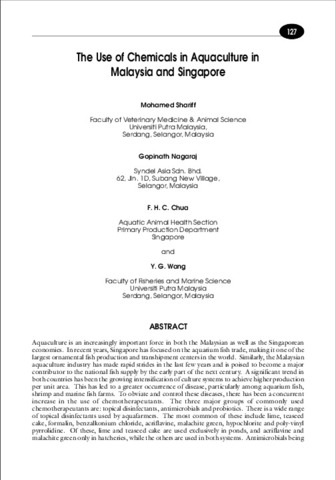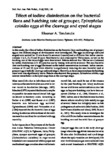Perlihatkan publikasi sederhana
In vitro and in vivo evaluation of the efficacies of commercial probiotics and disinfectant against acute hepatopancreatic necrosis disease and luminescent vibriosis in Litopenaeus vannamei
| dc.contributor.author | de la Peña, Leobert D. | |
| dc.contributor.author | Moquera, Germin L. | |
| dc.contributor.author | Amar, Edgar | |
| dc.contributor.author | Castellano, Jose Louis A. | |
| dc.contributor.author | Cabillon, Nikko Alvin R. | |
| dc.contributor.author | Arboleda, Joey I. | |
| dc.contributor.author | Nava, Joseph Keith Paulo | |
| dc.contributor.author | Zamora, Rodolfo V. Jr. | |
| dc.contributor.author | De Schryver, Peter | |
| dc.coverage.spatial | Negros Occidental | en |
| dc.coverage.spatial | Philippines | en |
| dc.date.accessioned | 2024-03-12T09:04:48Z | |
| dc.date.available | 2024-03-12T09:04:48Z | |
| dc.date.issued | 2024-05 | |
| dc.identifier.citation | de la Peña, L. D., Moquera, G. L., Amar, E. C., Castellano, J. L. A., Cabillon, N. A. R., Arboleda, J. I., Nava, J. K. P. T., Zamora, R. V., & De Schryver, P. (2024). In vitro and in vivo evaluation of the efficacies of commercial probiotics and disinfectant against acute hepatopancreatic necrosis disease and luminescent vibriosis in Litopenaeus vannamei. Research in Veterinary Science, 171, 105204. https://doi.org/10.1016/j.rvsc.2024.105204 | en |
| dc.identifier.issn | 0034-5288 | |
| dc.identifier.uri | http://hdl.handle.net/10862/6523 | |
| dc.description.abstract | The bioactivities of two commercially available probiotics and one chemical disinfectant were tested against strains of Vibrio parahaemolyticus (VPAHPND) and V. harveyi. This study aimed to determine shrimp pathogenic Vibrios' in vitro and in vivo sensitivities to commercial probiotics and a chemical disinfectant. The probiotics and disinfectant were tested first in vitro, followed by the in vivo trials. Results showed that upon administration of probiotics either through diet or adding into the tank water, the survivability of shrimp was increased during challenge with VPAHPND and V. harveyi. Also, the disinfectant was tested against the same pathogens and showed positive bactericidal effects at 2500 ppm and 5000 ppm. The present findings suggest that adding probiotics to the rearing water or the shrimp feeds effectively prevents infection by lowering the load of pathogenic bacteria. In comparison, the effectiveness of the disinfectant (PUR) depends on its appropriate concentration and timing of application. It is not only limited to rearing water but is also applicable for decontaminating pond liners, tanks, and other paraphernalia. | en |
| dc.description.sponsorship | Special thanks to the Southeast Asian Fisheries Development Center/Aquaculture Department for the support (FH-01-C2016T), the shrimp farm for providing experimental animals, and the Fish Health Section staff for assistance during this study. The authors acknowledge Miguel Leal for their comments to improve the quality of the manuscript. | en |
| dc.language.iso | en | en |
| dc.publisher | Elsevier | en |
| dc.subject | Vibrio parahaemolyticus | en |
| dc.subject | Penaeus vannamei | en |
| dc.subject | in vitro | en |
| dc.subject | Bacillus | en |
| dc.subject.lcsh | Shrimps | en |
| dc.title | In vitro and in vivo evaluation of the efficacies of commercial probiotics and disinfectant against acute hepatopancreatic necrosis disease and luminescent vibriosis in Litopenaeus vannamei | en |
| dc.type | Article | en |
| dc.identifier.doi | 10.1016/j.rvsc.2024.105204 | |
| dc.citation.volume | 171 | en |
| dc.citation.spage | 105204 | en |
| dc.citation.journalTitle | Research in Veterinary Science | en |
| dc.subject.asfa | probiotics | en |
| dc.subject.asfa | diseases | en |
| dc.subject.asfa | vibriosis | en |
| dc.subject.asfa | aquaculture | en |
| dc.subject.asfa | disinfection | en |
| dc.subject.scientificName | Vibrio parahaemolyticus | en |
| dc.subject.scientificName | Vibrio harveyi | en |
| dc.subject.scientificName | Litopenaeus vannamei | en |
| dc.subject.scientificName | Penaeus vannamei | en |
| local.subject | shrimp | en |
| local.subject | commercial probiotics | en |
| local.subject | disinfection | en |
| local.subject | diseases | en |
| local.subject | Bacillus | en |
| local.subject | aquaculture | en |
| dc.subject.sdg | SDG 14 - Life below water |
Files in this item
| Files | Size | Format | View |
|---|---|---|---|
|
There are no files associated with this item. |
|||
Publikasi ini ada di koleksi berikut
-
Journal Articles [1258]
These papers were contributed by Department staff to various national and international journals.




